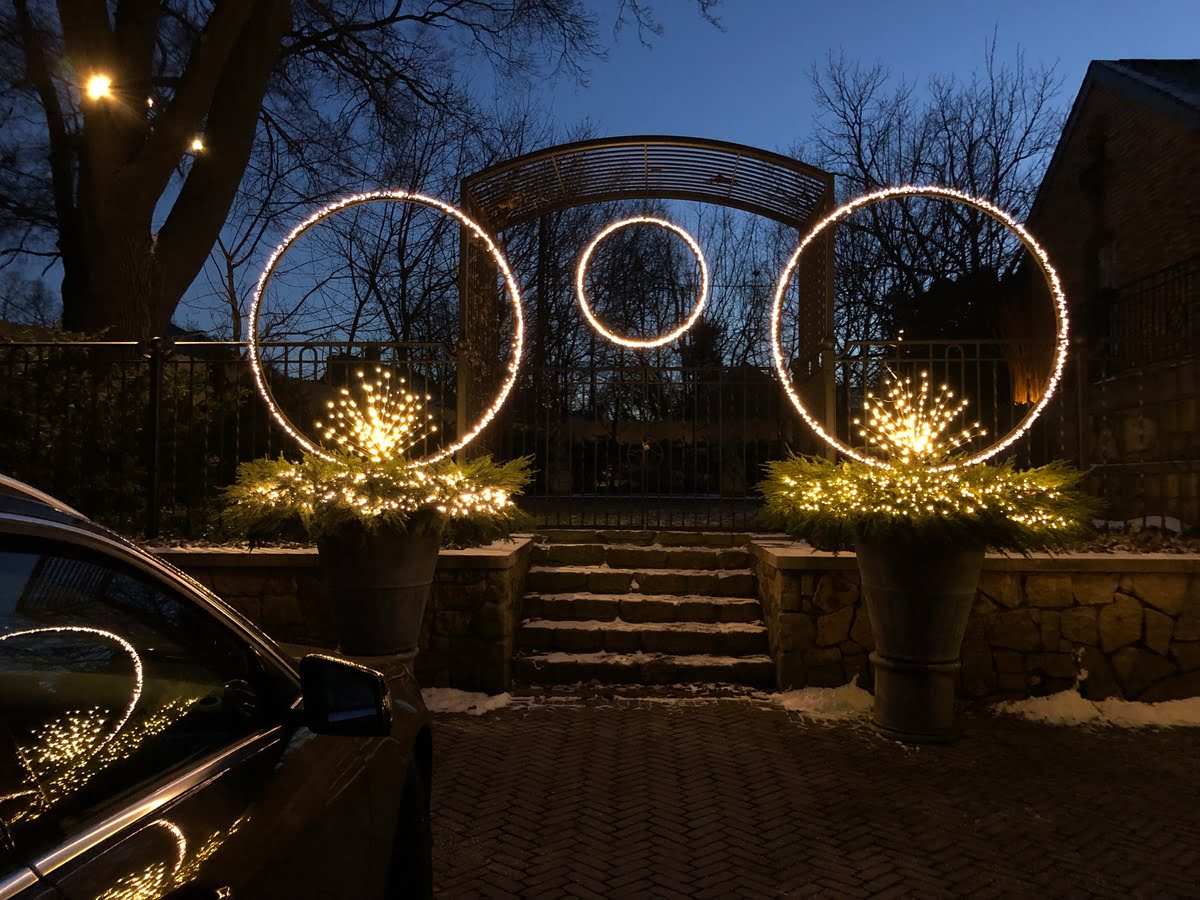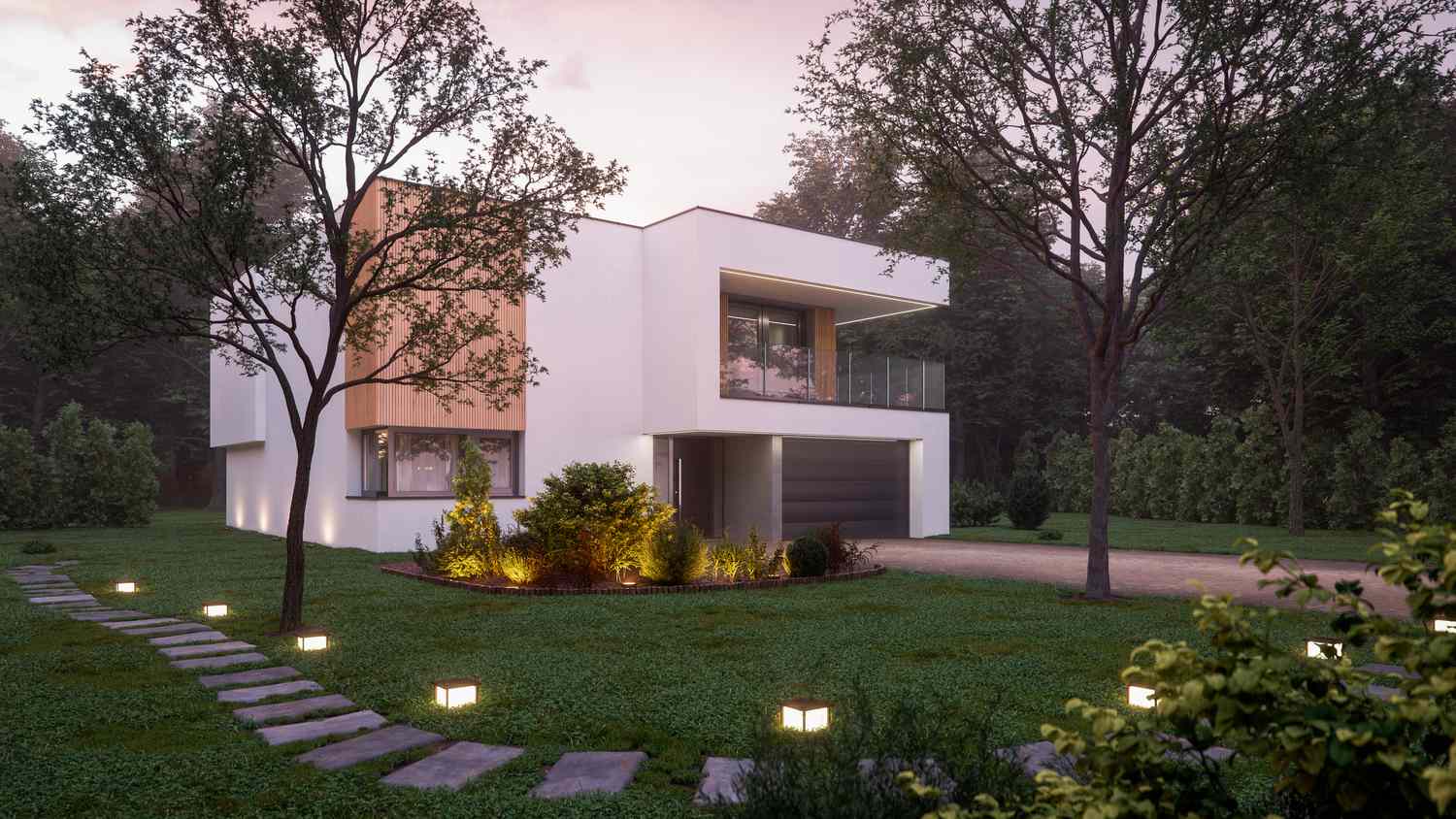Home>Gardening Techniques>DIY Projects>How To Light Up A Backyard


DIY Projects
How To Light Up A Backyard
Published: August 5, 2023
Learn how to light up your backyard with these DIY projects. Transform your outdoor space with unique and creative lighting solutions.
(Many of the links in this article redirect to a specific reviewed product. Your purchase of these products through affiliate links helps to generate commission for Chicagolandgardening.com, at no extra cost. Learn more)
Table of Contents
Introduction
Welcome to the world of DIY backyard lighting! Transforming your outdoor space into a well-lit haven not only adds functionality but also creates a warm ambiance for relaxing and entertaining. Whether you want to illuminate pathways, highlight specific areas, or set the mood for a cozy evening, there are endless possibilities when it comes to lighting up your backyard.
With a multitude of lighting options available, it may seem overwhelming to choose the right fixtures and determine the best placement for optimal effect. That’s where this comprehensive guide comes in. We will walk you through the process of planning, selecting, and installing outdoor lighting solutions that suit your style and enhance the beauty of your backyard.
Properly lighting your backyard not only improves its aesthetics but also provides safety and security. Well-placed lights can help prevent accidents by illuminating steps, walkways, and potential obstacles. Additionally, strategic lighting choices can also deter intruders and create a sense of security.
By the end of this article, you will have the knowledge and confidence to tackle your own DIY backyard lighting project. Whether you’re a beginner or an experienced DIY enthusiast, we’ve got you covered. So let’s dive in and shed some light on how to transform your backyard into a stunning outdoor oasis.
Planning Your Backyard Lighting
Before you begin installing your backyard lighting, it’s important to create a well-thought-out plan. Consider the functionality and aesthetic appeal you want to achieve, as well as the specific areas of your backyard that you want to highlight.
Start by assessing the layout of your outdoor space. Take note of any existing structures or features, such as trees, pergolas, or a patio. These can serve as natural focal points for your lighting design. Consider how you want to use each area, whether it’s for dining, lounging, or showcasing a particular element of your landscaping.
Next, determine the type of lighting you need for each area. Task lighting, such as overhead or wall-mounted fixtures, is ideal for specific activities like grilling or reading. Ambient lighting, on the other hand, creates a warm glow and fills the space with general illumination. Accent lighting can be used to highlight architectural features, plants, or artwork.
Once you have a clear idea of your lighting goals, create a rough sketch of your backyard. Mark the various zones and indicate where you plan to place each type of lighting. Consider the angles and directions of light in order to create depth and visual interest. Experiment with different layouts until you find the one that best suits your needs.
It’s also important to think about the power source for your backyard lighting. Determine if you have access to electrical outlets or if you will need to use solar-powered or low-voltage options. This will help you choose the right fixtures and ensure that your lighting system is safely and efficiently powered.
Lastly, think about the overall style and ambiance you want to create. Are you going for a cozy, rustic feel or a modern, sleek atmosphere? Consider the design elements of your backyard, such as the color scheme and materials used, and choose lighting fixtures that complement the existing aesthetics.
By taking the time to carefully plan your backyard lighting, you will ensure that your installation is both functional and visually appealing. So grab a pen and paper and start mapping out your lighting design – your backyard transformation is just around the corner!
Choosing the Right Lighting Fixtures
Once you have your plan in place, it’s time to select the right lighting fixtures for your backyard. With so many options available, it’s important to consider both the aesthetic and functional aspects of each fixture.
When it comes to outdoor lighting, durability is key. Look for fixtures that are specifically designed for outdoor use and are weather-resistant. Materials such as aluminum, stainless steel, and brass are excellent choices as they can withstand the elements and maintain their appearance over time.
Consider the type of lighting you need in each area of your backyard. For ambient lighting, hanging lanterns or string lights can create a warm and inviting atmosphere. Wall-mounted sconces can provide both ambient and task lighting, making them ideal for outdoor seating areas or entryways.
For pathways and stairways, choose fixtures that provide adequate illumination to ensure safety. Bollard lights, stake lights, or well lights are good options for adding visibility to these areas. Along with pathway lighting, consider adding step lights or integrated lighting in stairs to prevent accidents and enhance the aesthetic appeal.
When it comes to accent lighting, there are various options to choose from. Spotlights and floodlights can be used to highlight specific features, such as trees, sculptures, or architectural elements. Consider using adjustable fixtures to easily change the focus and direction of the light.
If you want to create a magical atmosphere, consider incorporating string lights or fairy lights. These can be wrapped around trees or suspended overhead to create a whimsical and enchanting effect. Solar-powered options are also available, making them energy-efficient and easy to install.
Another important aspect to consider is the lighting color. Warm white lights create a cozy and inviting ambiance, while cool white lights provide a more modern and crisp look. You can also opt for colored lights to add a festive touch to your backyard during holidays or special occasions.
Don’t forget to consider the maintenance of your lighting fixtures. Ensure that they are easy to clean and replace if necessary. LED lighting options are not only energy-efficient but also have a longer lifespan, reducing the need for frequent replacements.
By carefully selecting the right lighting fixtures for your backyard, you can enhance both the functionality and aesthetics of your outdoor space. Take the time to research different options and consider how each fixture fits into your overall lighting design. With the right fixtures, your backyard will be perfectly illuminated and ready for enjoyment day and night.
Installing Outdoor Lighting
Now that you have chosen the right lighting fixtures for your backyard, it’s time to start the installation process. While the specific steps may vary depending on the type of lighting and your landscape, here are some general guidelines to help you get started.
First and foremost, ensure that you have the necessary tools and equipment for the installation. This may include a shovel, wire cutters, a voltage tester, and a drill. Additionally, if you are dealing with electrical wiring, it’s essential to turn off the power supply to the area before beginning any work.
If you are installing pathway or accent lighting, start by mapping out the desired locations for each fixture. Use a stake or marking flags to determine the precise placement. It’s a good idea to install the fixtures at regular intervals to ensure even illumination and a visually balanced effect.
Next, you’ll need to prepare the ground for the installation. Use a shovel or garden trowel to dig out the area where the fixtures will be placed. This will allow you to bury any wiring and create a secure foundation for the fixtures.
If electrical wiring is involved, follow local building codes and guidelines for outdoor electrical installations. Use conduit to protect the wiring and ensure it is buried at the appropriate depth. This will help prevent damage and potential hazards.
Once the groundwork is prepared, it’s time to install the fixtures. Follow the manufacturer’s instructions for each specific fixture, ensuring proper wiring connections and securely anchoring them in place. Test each fixture to verify that it is working correctly before moving on to the next one.
If you are dealing with solar-powered or low-voltage lights, the installation process may be simpler. Solar lights typically require no wiring, and low-voltage systems use a transformer to step down the electrical output, making them safe and easy to install.
When installing wall-mounted fixtures, make sure they are securely attached to the wall using the appropriate hardware. Be mindful of the height and angle of the fixtures to achieve the desired lighting effect and prevent any glare or shadows.
Lastly, make sure that all connections are properly sealed to protect them from moisture and weather elements. Use waterproof connectors and sealant to ensure a secure and durable installation.
Remember, if you are unsure about any aspect of the installation process, it is always recommended to consult with a professional electrician or contractor. They can provide guidance and ensure that your outdoor lighting is installed safely and efficiently.
With careful planning and proper installation, your backyard lighting will add both beauty and functionality to your outdoor space, allowing you to enjoy your backyard day and night.
Types of Outdoor Lighting
When it comes to outdoor lighting, there are various types and styles to choose from, each serving a specific purpose and creating a unique ambiance. Understanding the different options available will help you make informed choices for your backyard. Here are some of the most popular types of outdoor lighting:
1. Pathway Lights: These lights are perfect for illuminating walkways, driveways, and garden paths. They provide safety by guiding your steps and adding a touch of elegance to your landscape. Pathway lights can be installed at ground level or mounted on stakes.
2. Spotlights: Spotlights are powerful, focused lights that are used to highlight specific features in your backyard, such as trees, sculptures, or architectural elements. They create a dramatic effect and draw attention to the focal point.
3. Floodlights: Similar to spotlights, floodlights emit a broad beam of light, covering a larger area. They are commonly used for security purposes or to illuminate a wide space, such as a backyard or outdoor event area.
4. Wall-mounted Lights: These lights are fixed to vertical surfaces, such as walls or fences. They provide both ambient and task lighting and are ideal for outdoor seating areas, entryways, or patio walls. Wall-mounted lights come in various styles, including sconces and lanterns.
5. Hanging Lights: Hanging lights, such as lanterns or pendant lights, add a touch of charm and elegance to your outdoor space. They are often used in covered spaces, such as porches or pergolas, and are available in different designs and materials.
6. Step Lights: Step lights are installed on or near stairs to provide illumination and prevent accidents. They can be recessed in the ground or mounted on the surface, ensuring safe navigation in dimly lit areas.
7. String Lights: String lights are a popular choice for creating a magical and whimsical atmosphere in your backyard. They can be suspended overhead, wrapped around trees, or used to define boundaries and create a cozy ambiance.
8. Solar Lights: Solar-powered lights are an energy-efficient and sustainable option for outdoor lighting. They use solar panels to absorb sunlight during the day and automatically turn on at dusk. Solar lights come in various styles and can be easily placed anywhere in your backyard.
Remember to consider the specific needs and aesthetic appeal of your backyard when choosing the type of outdoor lighting. Combine different types of lighting to achieve the desired effect and create a well-lit and stunning outdoor space.
Incorporating Landscape Lighting
Landscape lighting plays a crucial role in highlighting the beauty of your outdoor space and creating a captivating ambiance. It not only enhances the visual appeal but also adds depth and dimension to your landscaping. Here are some tips on how to incorporate landscape lighting effectively:
1. Highlight Architectural Features: Install lights to accentuate the unique architectural elements of your home, such as columns, pillars, or a facade. This adds elegance and draws attention to the distinctive features of your property.
2. Illuminate Trees and Plants: Use uplights or downlights to showcase the beauty of your trees and plants. This creates a dramatic effect and adds texture to your landscape. Experiment with different angles and distances to achieve the desired lighting effect.
3. Create Layers of Lighting: Combine different types of lighting, such as pathway lights, spotlights, and accent lights, to create layers of illumination. This adds depth and dimension to your landscaping, creating a visually stunning effect.
4. Consider Color Temperature: Pay attention to the color temperature of your landscape lighting to create the desired mood. Warm white lights create a cozy and intimate atmosphere, while cool white lights provide a modern and crisp look.
5. Use Lighting to Define Spaces: Use lighting to define different areas of your backyard, such as patio, seating areas, or garden beds. This helps create a sense of structure and purpose in your outdoor space, making it more inviting and functional.
6. Water Feature Lighting: If you have a pond, fountain, or waterfall in your backyard, consider incorporating lighting to highlight these water features. Underwater LED lights or spotlights can create a magical and enchanting effect.
7. Install Step and Path Lights: Ensure the safety of your outdoor areas by installing step lights and path lights. These lights not only provide illumination but also prevent accidents by clearly marking the path and steps.
8. Use Dimmers and Timers: Incorporate dimmers and timers into your landscape lighting system to control the brightness and automate the lighting schedule. This allows you to adjust the lighting according to different occasions and save energy.
Remember to strike a balance between functionality and aesthetics when incorporating landscape lighting. Experiment with different techniques and placements to create a visually pleasing and inviting outdoor space that you can enjoy day and night.
Enhancing Safety and Security
Outdoor lighting doesn’t just enhance the aesthetic appeal of your backyard; it also plays a critical role in enhancing safety and security. Well-placed lighting can help prevent accidents, deter intruders, and provide peace of mind. Here’s how you can enhance safety and security with your outdoor lighting:
1. Illuminate Pathways and Staircases: Install pathway lights and step lights to ensure safe navigation around your backyard. These lights can help prevent slips, trips, and falls, especially in areas with uneven surfaces or changes in elevation.
2. Light Up Entrances and Exits: Install bright and well-positioned lighting near entrances, exits, and doorways to deter potential intruders. Motion-sensor lights can be particularly effective in surprising and deterring anyone attempting to enter your property without permission.
3. Use Motion-Activated Lighting: Motion-activated lights are an excellent security feature for your backyard. They automatically turn on when they detect movement, alerting you to any activity and potentially scaring away unwanted guests.
4. Utilize Floodlights for Wide Coverage: Install floodlights to provide broad coverage of your backyard. This helps ensure that every corner is well-lit, minimizing hiding spots for intruders. Floodlights with a motion-sensing feature can provide an added layer of security by instantly illuminating the area when triggered.
5. Consider Security Cameras with Integrated Lighting: To enhance security further, you can invest in outdoor security cameras with built-in lighting. These cameras not only capture clear footage but also help deter potential criminals with their bright illumination.
6. Opt for Timers or Smart Lighting Systems: Timers or smart lighting systems allow you to automate your outdoor lighting, making it appear as if someone is home even when you’re away. This helps give the impression that your property is occupied, deterring burglars.
7. Keep Lights Well-Maintained: Regularly check and maintain your outdoor lighting fixtures to ensure they are always in working order. Replace any burnt-out bulbs promptly to maintain consistent illumination throughout your backyard.
Remember to find the right balance between security and aesthetics. Strategically placed lighting can enhance safety and security without compromising the overall look and feel of your backyard. By incorporating these measures, you can create a well-lit and secure outdoor space for you and your family to enjoy.
Creating Ambiance with Mood Lighting
One of the most exciting aspects of outdoor lighting is the ability to create ambiance and set the mood in your backyard. With the right lighting techniques, you can transform your outdoor space into a magical oasis for relaxation, entertainment, or romantic evenings. Here are some ideas for creating ambiance with mood lighting:
1. String Lights: String lights are a popular choice for adding a warm and inviting atmosphere to your backyard. They can be hung across a patio, wrapped around tree trunks, or suspended above a seating area to create a cozy and enchanting ambiance.
2. Candlelight and Lanterns: Candles and lanterns provide a soft and intimate glow, perfect for creating a romantic atmosphere. Place them on tables, along pathways, or in hanging lanterns to add a touch of elegance and warmth to your outdoor space.
3. Colored Lights: Incorporating colored lights can set a specific mood or theme in your backyard. Use different colored bulbs or color-changing LED lights to create a festive atmosphere for parties or to evoke a calming aura for relaxation.
4. Fire Features: Install fire pits, fire bowls, or torches to add a flickering warmth and natural glow to your outdoor space. The dancing flames provide both light and a cozy ambiance, perfect for gathering around and enjoying cooler evenings outdoors.
5. Outdoor Wall Sconces: Wall-mounted sconces offer a subtle and sophisticated way to create a soothing ambiance. They can be placed along walls, fences, or outdoor structures to provide a soft and gentle glow.
6. Strategic Downlighting: Use downlighting techniques to create a moonlit effect in your backyard. Install powerful downlights high up in trees or on pergolas to cast a soft and gentle glow that mimics the beauty of moonlight.
7. Dimmers and Controls: Incorporate dimmers and lighting controls to adjust the brightness of your outdoor lighting. This allows you to create different levels of ambiance depending on the occasion or your desired mood.
8. Waterfall and Fountain Lighting: If you have a water feature like a waterfall or fountain, consider adding lighting to highlight the flowing water. This creates a serene and tranquil atmosphere, perfect for unwinding and relaxation.
When creating ambiance with mood lighting, consider the desired atmosphere for your outdoor space. Whether you prefer a romantic setting, a vibrant and lively atmosphere, or a tranquil retreat, the right lighting choices can transform your backyard into a captivating oasis.
Maintaining and Repairing Outdoor Lighting
Maintaining and periodically checking your outdoor lighting is essential to ensure it remains in optimal condition and continues to function effectively. By following some simple maintenance and repair practices, you can extend the lifespan of your lighting fixtures and keep your backyard looking its best. Here are some tips:
1. Regular Cleaning: Outdoor lighting fixtures can accumulate dirt, dust, and debris over time, diminishing their brightness and effectiveness. Clean the fixtures regularly using a soft cloth or sponge and mild soapy water. Avoid using harsh chemicals or abrasive materials that can damage the fixtures.
2. Inspect for Damage: Routinely inspect your outdoor lighting fixtures for any signs of damage, such as broken casings, loose wires, or corroded connectors. Detecting and addressing issues early on will prevent further damage and ensure proper functionality.
3. Replace Faulty Bulbs: Burnt-out or dim bulbs can diminish the overall effect of your outdoor lighting. Regularly check the bulbs and replace any that are not functioning properly. Follow the manufacturer’s instructions to ensure you use the correct replacement bulbs.
4. Check Electrical Connections: Inspect the electrical connections of your outdoor lighting system to ensure they are secure and properly insulated. Loose or damaged connections can cause the lighting to flicker or stop working altogether. If you notice any issues, consult a professional electrician for repairs.
5. Test the System: Regularly test your outdoor lighting system to ensure everything is functioning as intended. Turn on each fixture and check for adequate illumination. If any lights fail to turn on or are not functioning properly, troubleshoot the problem or seek professional assistance.
6. Prioritize Safety: Whenever performing maintenance or repairs on your outdoor lighting, prioritize safety. Before working on any electrical components, ensure the power is turned off to prevent any accidents. If you’re uncertain about handling electrical work, it is best to hire a licensed electrician.
7. Seek Professional Help: If you encounter complex issues or are unsure how to troubleshoot problems, it’s best to enlist the help of a professional. Certified electricians or lighting specialists can handle more intricate repairs and ensure your outdoor lighting is in optimal condition.
By regularly maintaining and promptly addressing any issues with your outdoor lighting, you can ensure its longevity and enjoy a beautifully lit backyard for years to come. Don’t overlook the importance of routine maintenance, as it can save you time and money down the line.
Conclusion
Congratulations! You’ve reached the end of this comprehensive guide on DIY backyard lighting. By following the tips and techniques outlined in this article, you now have the knowledge and confidence to transform your outdoor space into a well-lit and enchanting oasis.
Remember, the key to successful backyard lighting is careful planning, choosing the right fixtures, proper installation, and regular maintenance. Take the time to assess your outdoor space, determine your lighting goals, and create a detailed plan. Consider the different types of lighting available and how they can enhance both the functionality and ambiance of your backyard.
Whether you prefer to install pathway lights to guide your steps, accent lights to highlight architectural features, or string lights for a cozy and dreamy atmosphere, the possibilities are endless. Be creative and experiment with different lighting techniques to achieve the desired effect.
Additionally, don’t forget about the importance of safety and security. Incorporate lighting to illuminate pathways, entrances, and exits, and consider motion-activated lights and security cameras for added peace of mind.
Maintaining and repairing your outdoor lighting is also crucial to ensuring its longevity. Regularly clean the fixtures, inspect for damage, and replace faulty bulbs or electrical connections as needed. By staying on top of maintenance, you can keep your outdoor lighting in perfect working condition.
Now it’s time to put your newfound knowledge into action and start your own DIY backyard lighting project. So grab those tools, select your lighting fixtures, and let your creativity shine bright. Transform your backyard into a stunning outdoor sanctuary where you can relax, entertain, and create lasting memories.
Remember, outdoor lighting is not only functional but also a form of artistic expression. Enjoy the process, and don’t be afraid to get creative with your lighting design. With the right lighting, your backyard will become a breathtaking extension of your home.







